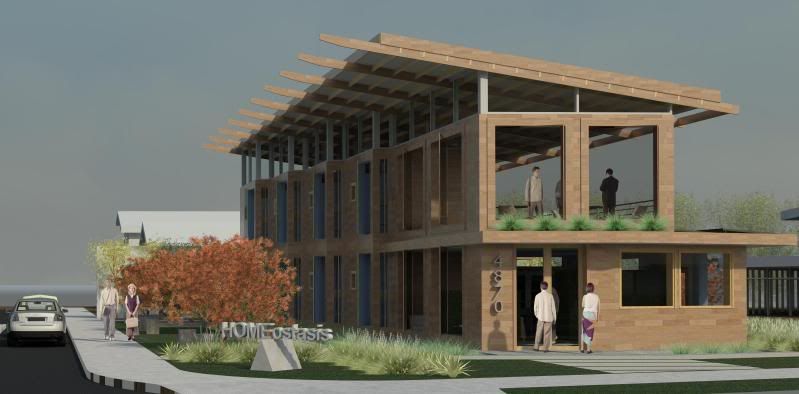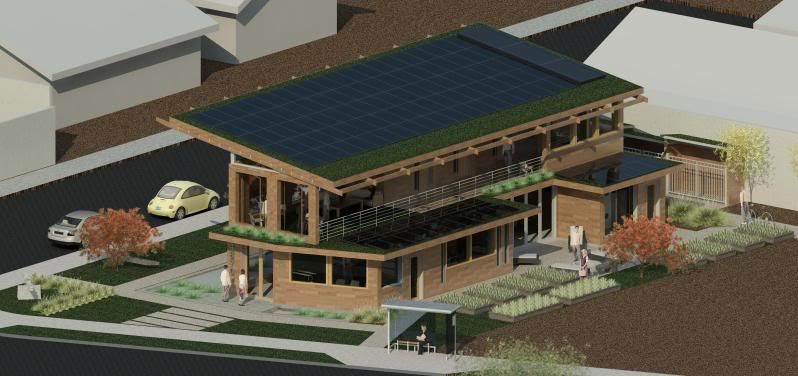A competition entry for a net-zero energy dormitory. You can read the official competition requirements and description here: Leading Edge Competition My entry is for Challenge 2. After being frustrated for a while and changing up the design a few times, I'm pretty happy with it.
 Homeostasis: hō-mē-ō-stā-sәs The maintenance of relatively constant conditions within the internal environment. To maintain homeostasis, the organism must be kept in balance. The organism in this context is the building; to be in balance means that what comes into the building and what is produced by the building must equal the sum of what is used and what is eliminated. This concept applies to thermoregulation, waste management, electricity consumption, material resources and water management. My proposal for the dormitory is to create a building that maintains this balance. The building itself will not maintain the balance alone; the interaction of the residents will play an important and vital role in the maintenance of the systems and functions of the building. The residents will not only serve the building. The building will trade the services of its inhabitants for the education that they will gain by operating, managing and sustaining their home.
Homeostasis: hō-mē-ō-stā-sәs The maintenance of relatively constant conditions within the internal environment. To maintain homeostasis, the organism must be kept in balance. The organism in this context is the building; to be in balance means that what comes into the building and what is produced by the building must equal the sum of what is used and what is eliminated. This concept applies to thermoregulation, waste management, electricity consumption, material resources and water management. My proposal for the dormitory is to create a building that maintains this balance. The building itself will not maintain the balance alone; the interaction of the residents will play an important and vital role in the maintenance of the systems and functions of the building. The residents will not only serve the building. The building will trade the services of its inhabitants for the education that they will gain by operating, managing and sustaining their home. Part of the competition was to use real calculations and analyses to let environmental decisions influence and inform the design.
Part of the competition was to use real calculations and analyses to let environmental decisions influence and inform the design. Evolution of Form
The original concept was a 3 story building with a north facing curtain wall to optimize daylighting. Using Ecotect’s comfort analysis tool, it was evident that the third floor rooms would require air conditioning. In the mild climate of Long Beach, a passive solution should be possible. Other strategies to minimize the need were first explored. The roof form was developed in order to maximize surface area for photovoltaics. This inefficient design needed that area and perhaps more, so the strategy was to reduce the demand.
The original concept was a 3 story building with a north facing curtain wall to optimize daylighting. Using Ecotect’s comfort analysis tool, it was evident that the third floor rooms would require air conditioning. In the mild climate of Long Beach, a passive solution should be possible. Other strategies to minimize the need were first explored. The roof form was developed in order to maximize surface area for photovoltaics. This inefficient design needed that area and perhaps more, so the strategy was to reduce the demand.

Original Concept Building: Yes it is ugly
The first step in transforming this building was to eliminate the third floor. The loss of square footage required a major shift in layout. Bedrooms were moved from the north side of the building and clustered on the east. This meant that some bedrooms were now on the south facing side. While overall, the temperatures were more reasonable, aesthetically, the structure was unbalanced and straying from the driving concept of homeostatic balance. This configuration provided adequate roof area for photovoltaics, however minimal surplus power could be generated.

First Iteration
The final iteration of the form results in a building where inhabitants and inhabited work as one organism to maintain and operate its systems. The placement of the bedrooms along the north side of the building as in the first run help to maintain more constant temperature ranges throughout the year. This orientation allows for more natural light in each room as well. Staggering the rooms allowed for placement of pivoting windows at the cooling pond directly in line with the prevailing westerly winds. Radiant in floor heating supplied by the solar hot water collectors provides heat on the coldest days. The planted perimeter of the roofs becomes the primary treatment of rainwater and the slope of the roof drains this water into the cooling pond directly. High efficiency appliances and the elimination of mechanical air conditioning reduced demand by over 50% from the original concept. See Appendix A for electricity demands and production. High efficiency photovoltaic panels provide nearly 150% of the energy needs for the dormitory. The surplus can be sold back to the grid or used at the adjacent training facility.
 Thermoregulation is the key component in the maintenance of occupant comfort. The mild climate of Long Beach seems to solicit systems which utilize the natural tendencies of the area. The regularity of offshore air currents are harnessed to help balance the heat of summer days. The abundant sunshine year round will provide heat on the few days that require it. An organism’s primary system for thermoregulation is its skin. This holds true for the dormitory as well. All exterior walls are 10 inches thick with 7 1/2 inches of closed cell soy-based foam insulation. Most windows are operable, pivoting windows that the residents will be in control of to allow or block airflow. At the north and west facades, an evaporative cooling pond supplied by rain and greywater will cool the prevailing winds before they enter the building. When closed, the dual double-paned argon-filled panels will help maintain the comfort level. Much as the cardiovascular system sends blood around the body, the solar heated water that flows through the radiant floor heating system will keep the occupants warm on the coldest nights. An integral part of the balance are the residents themselves; they must maintain and operate these vital systems.
Thermoregulation is the key component in the maintenance of occupant comfort. The mild climate of Long Beach seems to solicit systems which utilize the natural tendencies of the area. The regularity of offshore air currents are harnessed to help balance the heat of summer days. The abundant sunshine year round will provide heat on the few days that require it. An organism’s primary system for thermoregulation is its skin. This holds true for the dormitory as well. All exterior walls are 10 inches thick with 7 1/2 inches of closed cell soy-based foam insulation. Most windows are operable, pivoting windows that the residents will be in control of to allow or block airflow. At the north and west facades, an evaporative cooling pond supplied by rain and greywater will cool the prevailing winds before they enter the building. When closed, the dual double-paned argon-filled panels will help maintain the comfort level. Much as the cardiovascular system sends blood around the body, the solar heated water that flows through the radiant floor heating system will keep the occupants warm on the coldest nights. An integral part of the balance are the residents themselves; they must maintain and operate these vital systems.Waste Management is another important function necessary for maintaining the balance. Living organisms process what they consume, getting the most out of their food while packaging the waste efficiently. This building has systems in place that do much of the same. A comprehensive recycling program is the first step. A composting system which consists of terraced worm bins that produce excellent material used in the backyard edible garden will handle organic waste produced from the kitchen. Greywater from showers and sinks will be treated in a tertiary treatment system that culminates in the cooling pond. Again, like the thermoregulation systems, the residents will need to play a role in the operation of these processes.
Power production and consumption is the third component of homeostasis. As animals, we take in fuel and convert this fuel to energy. The building will do the same. The fuel in this case is light from the sun. Long Beach gets almost 6 hours per day of sun strong enough for photovoltaic systems to generate power. A solar array of 130, 210w panels will provide all of the necessary electricity plus a surplus that can be sold back to the grid or used by the adjacent education center. The surplus will provide an estimated $1570 annually. Detailed information can be found in the accompanying data packet.
Material resources take the concept of balance beyond the site. The use of reclaimed wood for siding and flooring keeps the material from trees harvested over 100 years ago in use. These woods are sourced from a local yard in Temecula less than 80 miles away. Where the use of reclaimed wood is not viable, Forestry Stewardship Council certified wood is specified. The concrete used for the foundation and pond will be composed of fly-ash as the primary binder. This will effectively “sink” some the carbon produced by the coal fired power plants that dominate Southern California’s power sources. Decomposed granite pathways and patios will allow for the percolation of uncollected rainwater back into the aquifer while also minimizing the use of water intensive landscape materials. Plantings have been carefully chosen for the project to negate the need for permanent irrigation and provide an edible garden. Native California grasses such as Leymus Condensatus that require no water in this climate and can tolerate shade or sun while maintaining their color will be used. Citrus trees will be planted and maintained by the residents, providing fruit and shade.
All of these systems combined with the interaction of the residents form a complete and balanced home for the future workers. The building will help to educate the students that must operate the systems. The lower roof photovoltaics will provide a daily reminder of where their power comes from. The reflective cooling pond will teach them the importance of conserving and recycling Southern California’s limited water supply. The edible garden and compost bins will teach them how live in conjunction with the land and the resources it provides. The homeostatic balance between building, resident, site and earth will provide an example that the residents will take with them once they’ve completed the program and returned to their neighborhoods to make those places more balanced.

Project book and datasets available upon request.

Wall Section









Looks Rad build me one, can it be a 2 bedroom?
ReplyDelete